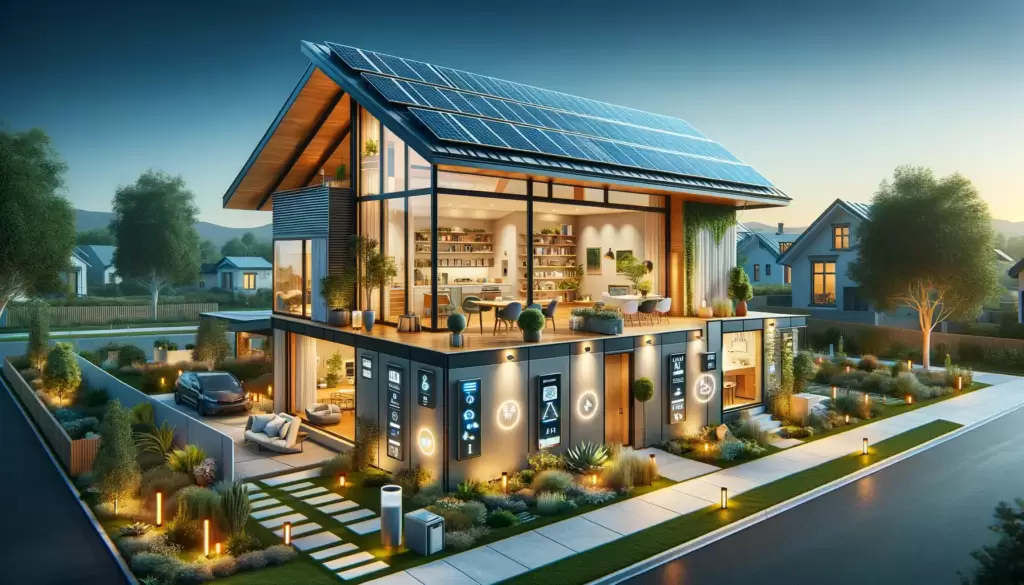
Table of Contents
Introduction: Understanding energy-efficient home design
Did you know that incorporating energy-efficient design into your home can lead to more than just lower utility bills? Beyond the financial benefits, prioritizing energy efficiency can also contribute to a more sustainable future. By reducing your energy consumption, you are actively participating in the global effort to decrease greenhouse gas emissions and combat climate change. Additionally, an energy-efficient home design can enhance your overall quality of life by creating a comfortable and healthy living environment. With better insulation, efficient appliances, and smart lighting choices, you can enjoy a cozy space while minimizing environmental impact.
Moreover, embracing energy efficiency in home designs aligns with modern architectural trends and consumer preferences. As sustainability becomes an increasingly important factor in people’s lives, eco-friendly features add long-term value to homes. Not only does it save homeowners money on operating costs, but it also enhances the resale value of their property. Designing with energy efficiency in mind is not just about embracing a responsible lifestyle; it’s also about investing in the future marketability and desirability of your home.
Key Principles of Energy-Efficient Design
In the quest for energy efficiency, incorporating passive design strategies is crucial. By strategically positioning windows and using shading elements, homes can benefit from natural light and ventilation while minimizing the need for artificial heating and cooling. Furthermore, the use of energy-efficient materials such as insulated concrete forms (ICFs) and low-emissivity (low-e) windows can significantly reduce heat loss and gain, thereby decreasing overall energy consumption.
Another key principle is the integration of renewable energy systems into home designs. Utilizing solar panels, wind turbines, or geothermal systems can generate clean energy on-site, reducing reliance on traditional power sources and ultimately lowering carbon emissions. Additionally, smart home technologies like programmable thermostats and energy monitoring systems empower homeowners to optimize their energy usage in real-time.
By centering designs around these key principles of passive strategies, efficient materials, and renewable technology integration, homeowners not only reduce their environmental impact but also save on long-term utility costs. This approach to sustainable design not only benefits individual households but also contributes to a more environmentally conscious society as a whole.
Key Principles of Energy-Efficient Design
Sustainable materials and techniques are at the forefront of modern home design, offering a plethora of benefits beyond environmental concerns. Integrating materials like reclaimed wood, bamboo, and recycled glass not only reduces the demand for virgin resources but also adds unique character to a home. Embracing techniques such as passive solar design and green roofs can significantly enhance energy efficiency while minimizing ecological impact. These initiatives not only contribute to sustainable living but also foster a healthier indoor environment by reducing toxins and pollutants commonly found in traditional building materials.
Innovative advancements in sustainable construction have expanded the possibilities for energy-efficient home designs. Leading-edge technologies, such as insulated concrete forms and low-impact development landscaping, provide durable solutions that reduce maintenance costs while promoting eco-friendly living spaces. By integrating these sustainable materials and techniques into home designs, homeowners can create comfortable, visually stunning environments that contribute positively to their well-being as well as the planet’s health.
Sustainable Materials and Techniques
In today’s fast-paced world, the importance of utilizing renewable energy sources cannot be overemphasized. Incorporating solar panels, wind turbines, and geothermal systems into home designs not only reduces the carbon footprint but also promotes sustainable living. These renewable energy sources offer a cost-effective and eco-friendly alternative to traditional energy options, providing homeowners with long-term savings while minimizing environmental impact.
Moreover, embracing renewable energy sources allows homeowners to take advantage of various government incentives and rebates. From tax credits to grants, there are numerous financial benefits that come with integrating renewable energy solutions into home designs. Additionally, the use of renewable energy can increase property value and appeal to environmentally conscious buyers in today’s real estate market. By making this forward-thinking investment in their homes, individuals can contribute to a greener future while reaping practical rewards for themselves.
Utilizing Renewable Energy Sources
Smart home technology integration is revolutionizing the way we interact with our living spaces, offering unparalleled convenience, comfort, and energy efficiency. By seamlessly connecting various devices and appliances through a central hub, homeowners can remotely control lighting, heating, cooling, and security systems with just a few taps on their smartphones or voice commands. The integration of smart thermostats can optimize energy usage by learning individual preferences and adjusting the temperature accordingly, resulting in significant cost savings for homeowners.
Furthermore, the implementation of smart plugs and switches allows for precise control over energy usage throughout the home. With the ability to schedule appliances to turn on and off at specific times or monitor their power consumption in real-time, homeowners can make informed decisions to reduce overall energy consumption. Additionally, integrating renewable energy sources such as solar panels with smart home technology enables efficient management of energy production and consumption, further promoting sustainability and reducing reliance on traditional power grids. With these advancements in smart home technology integration, creating an energy-efficient home design has never been more achievable or impactful.


Smart Home Technology Integration
In conclusion, the benefits of creating an energy-efficient home extend far beyond just saving money on utility bills. By reducing energy consumption, homeowners can significantly lower their environmental impact and contribute to a more sustainable future. Additionally, energy-efficient homes often provide better indoor air quality and comfort due to improved insulation and ventilation systems.
Moreover, investing in energy-efficient home designs can increase the overall value of the property while also attracting environmentally conscious buyers. It’s also worth noting that many governments and organizations offer incentives for adopting energy-efficient practices, providing further financial benefits for homeowners. Ultimately, creating an energy-efficient home not only brings immediate cost savings but also supports global efforts to mitigate climate change and create healthier living spaces for future generations.
Conclusion: Benefits of Creating an Energy-Efficient Home
In conclusion, the benefits of creating an energy-efficient home extend far beyond just lowering utility bills. By embracing energy-efficient home designs, homeowners can significantly reduce their carbon footprint, contributing to a more sustainable and eco-friendly future. Additionally, these homes often provide improved indoor air quality, better temperature regulation, and enhanced comfort for residents. Energy-efficient homes also tend to hold their value better in the real estate market and can even qualify for tax incentives or rebates, making them a sound investment for the long term.
Furthermore, by reducing energy consumption through efficient design choices such as insulation, LED lighting, and smart appliances, homeowners can play a crucial role in conserving natural resources and mitigating the impacts of climate change. As new technologies emerge and governments prioritize sustainability efforts, developing an energy-efficient home not only benefits individual households but also contributes to a broader global initiative towards environmental stewardship. Ultimately, creating an energy-efficient home is a meaningful way for individuals to make a positive impact on both their own lives and the planet as a whole.


